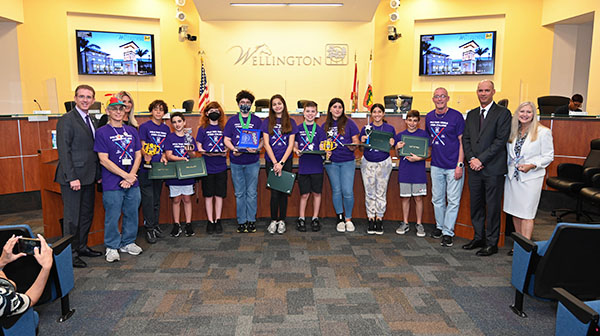
The Wellington Village Council on Tuesday, April 26 gave final approval to changes to the village’s sign code. While the overall intent was to bring the sign code in line with recent court rulings, the council also made additional changes, most notably to commercial window signs.
“The overall intent is to regulate location, size and number, but not infringe on constitutional rights,” Planning, Zoning & Building Director Tim Stillings said.
The first reading of the ordinance was held on April 12, and the council requested changes to how the sign code handles window signs.
“At first reading, there was a discussion about the window sign language,” Stillings said. “The language at first reading allowed for 50 percent of the window to be covered. The change in language would limit it to 50 percent of each window panel, not including any of the framing, and then only 25 percent of the overall window area.”
Mayor Anne Gerwig, who did not support the change regarding window signs, asked what would happen to existing signs that don’t meet the new criteria. Stillings said that they would become legal nonconforming signs, and the businesses would be able to keep their existing signs.
New window signs not meeting the new rules would need to get permission in advance.
“Businesses can apply for a technical deviation, but they would need to show the Architectural Review Board some compelling reason to allow it,” Stillings said. “We have also introduced an appeal to the Planning, Zoning & Adjustment Board from the ARB, whereas now, it goes from the ARB to the courts.”
Gerwig did not feel the change regarding window signs was necessary.
“I don’t support this change. I believe that 50 percent of the window façade allows a business to have some individual creativity with the type of signage they are going to do,” she said. “I do not believe our businesses abuse this. I have not heard a single complaint from residents on this issue.”
Councilman John McGovern disagreed. “I appreciate you doing this, and it was at my request. I think it is particularly helpful,” he said.
McGovern noted that Wellington expressly forbids murals, but the current code allows businesses “to cover all the windows because you have glass.”
“I’m perfectly fine with 50 percent of any window, but when we start combining windows and calling them one window, that is what brought this into question,” he said. “I think we have always been well-served as a community to keep signs and signage to a minimum.”
Gerwig said that the change to window signs does not fit with the goal of the sign code changes to make the code constitutional and content neutral, but McGovern pointed out that there are several changes to the sign code being made that are not specifically about the recent court rulings.
“I think this is a good change that further clarifies things as we have gone further and further with the amount of glass frontage that retail stores can have, in addition to all the other signage that businesses can have,” McGovern said.
There are a number of window signs in the village that are out of compliance of the old 50 percent rule due to the village not actively enforcing window sign coverings previously.
“The fact that we traditionally have not been policing this very well is not an excuse to not do anything. When we recognize that there is an issue, we should address it,” Vice Mayor Michael Drahos said. “We need to do something to protect the aesthetic appeal of Wellington, and we are not prohibiting a future business owner from seeking recourse if they disagree with our ordinance.”
McGovern pointed out that adding an appeal from the ARB to the PZAB is an improvement that allows businesses another opportunity to make their case.
A change was also suggested regarding election signs, allowing more time for them before the election date, but that was not changed, and remains at 30 days. Updated standards for temporary signs were included.
“I will not be supporting this because I think it is an undue disadvantage to a new business that comes in,” Gerwig said before the vote.
The second and final reading of the sign code changes passed 4-1 with Gerwig dissenting.
In other business, the council gave the final go-ahead for two election-related ballot questions that will go before Wellington voters on the Aug. 23 primary ballot.
The first of two ballot questions would clarify the village’s definition of term limits to specify that while a sitting council member can be elected mayor, a mayor cannot be elected to a council seat without first taking at least one year off the dais.
While Wellington’s charter sets a term limit of two four-year terms for the mayor and council members, Village Attorney Laurie Cohen has interpreted the charter wording to mean that a council member can serve all or part of two terms, and then serve two terms as mayor, and then immediately run again for a council seat.
Gerwig has been critical of this ballot question, calling it “the Anne Gerwig referendum,” since it would address her upcoming mayoral term limit in 2024. Other council members insisted that it was not specific to her, but it would clarify and uphold the spirit of the village’s term limit rules. This ballot question was approved 4-1 with Gerwig dissenting.
The second question would allow the village to designate the Palm Beach County Canvassing Board to serve as the Wellington Canvassing Board after municipal elections. The ballot question does not require the use of the county’s canvassing board. The village could still designate its own canvassing board if it wishes to, with a decision to be made before each election. This ballot question was approved unanimously.







